Applied Business Finance: Financial Management, Statements & Ratios
VerifiedAdded on 2022/12/27
|13
|2505
|68
Report
AI Summary
This report provides an evaluation of applied business finance, beginning with a definition and discussion of financial management and its importance in meeting operational expenses, financial planning, protecting business funds, fund allocation, and enhancing profitability. It describes the main financial statements—balance sheet, income statement, and cash flow statement—explaining their components and how they reflect a company's financial position and performance. The report also explains the utilization of ratios for financial management, including their role in forecasting, budgeting, assessing operational efficiency, and evaluating liquidity. Finally, the report includes a ratio analysis of a company's financial data to interpret its profitability, liquidity, and efficiency, concluding with insights into areas for improvement. Desklib offers a platform where students can find this and other solved assignments.

Applied
Business
Finance
Business
Finance
Paraphrase This Document
Need a fresh take? Get an instant paraphrase of this document with our AI Paraphraser
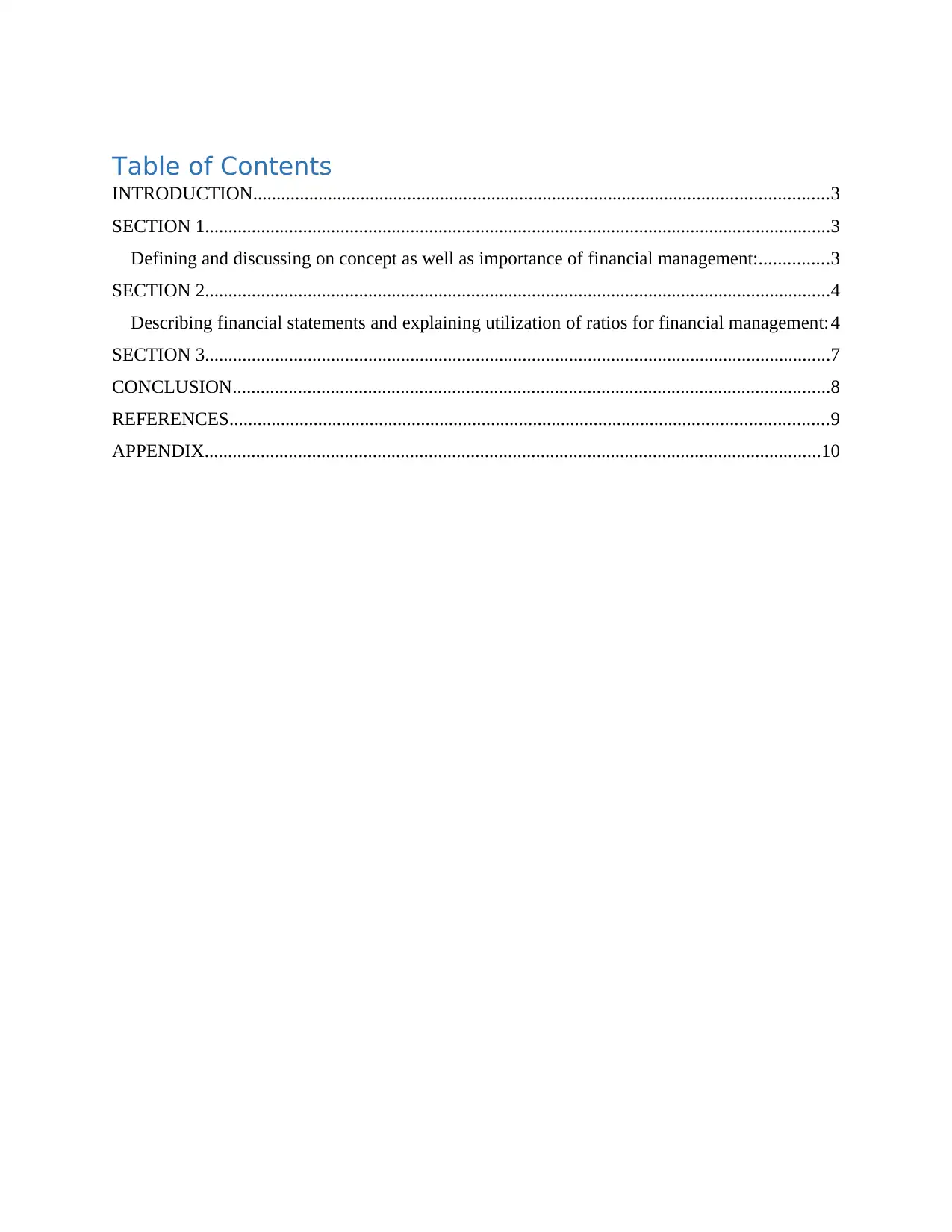
Table of Contents
INTRODUCTION...........................................................................................................................3
SECTION 1......................................................................................................................................3
Defining and discussing on concept as well as importance of financial management:...............3
SECTION 2......................................................................................................................................4
Describing financial statements and explaining utilization of ratios for financial management:4
SECTION 3......................................................................................................................................7
CONCLUSION................................................................................................................................8
REFERENCES................................................................................................................................9
APPENDIX....................................................................................................................................10
INTRODUCTION...........................................................................................................................3
SECTION 1......................................................................................................................................3
Defining and discussing on concept as well as importance of financial management:...............3
SECTION 2......................................................................................................................................4
Describing financial statements and explaining utilization of ratios for financial management:4
SECTION 3......................................................................................................................................7
CONCLUSION................................................................................................................................8
REFERENCES................................................................................................................................9
APPENDIX....................................................................................................................................10
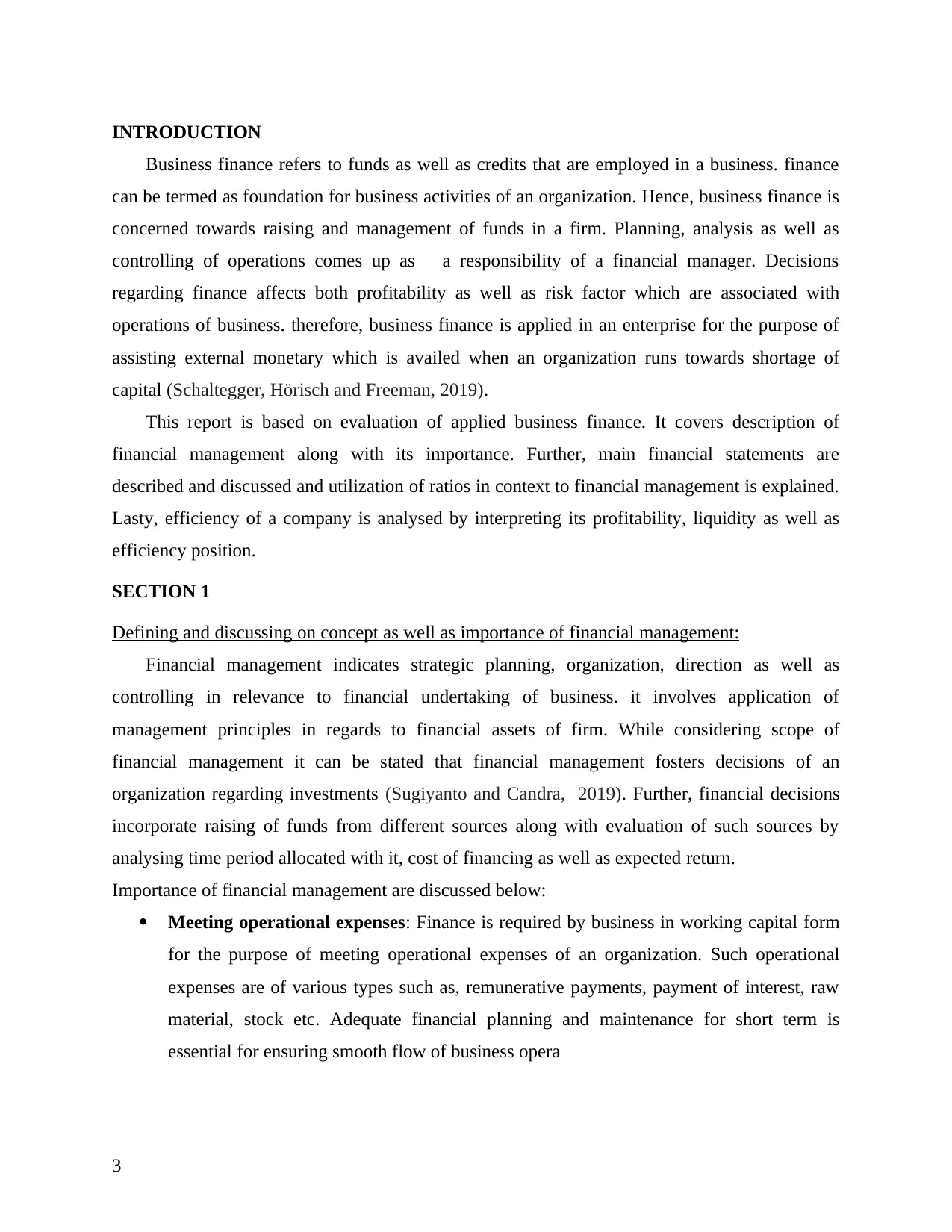
INTRODUCTION
Business finance refers to funds as well as credits that are employed in a business. finance
can be termed as foundation for business activities of an organization. Hence, business finance is
concerned towards raising and management of funds in a firm. Planning, analysis as well as
controlling of operations comes up as a responsibility of a financial manager. Decisions
regarding finance affects both profitability as well as risk factor which are associated with
operations of business. therefore, business finance is applied in an enterprise for the purpose of
assisting external monetary which is availed when an organization runs towards shortage of
capital (Schaltegger, Hörisch and Freeman, 2019).
This report is based on evaluation of applied business finance. It covers description of
financial management along with its importance. Further, main financial statements are
described and discussed and utilization of ratios in context to financial management is explained.
Lasty, efficiency of a company is analysed by interpreting its profitability, liquidity as well as
efficiency position.
SECTION 1
Defining and discussing on concept as well as importance of financial management:
Financial management indicates strategic planning, organization, direction as well as
controlling in relevance to financial undertaking of business. it involves application of
management principles in regards to financial assets of firm. While considering scope of
financial management it can be stated that financial management fosters decisions of an
organization regarding investments (Sugiyanto and Candra, 2019). Further, financial decisions
incorporate raising of funds from different sources along with evaluation of such sources by
analysing time period allocated with it, cost of financing as well as expected return.
Importance of financial management are discussed below:
Meeting operational expenses: Finance is required by business in working capital form
for the purpose of meeting operational expenses of an organization. Such operational
expenses are of various types such as, remunerative payments, payment of interest, raw
material, stock etc. Adequate financial planning and maintenance for short term is
essential for ensuring smooth flow of business opera
3
Business finance refers to funds as well as credits that are employed in a business. finance
can be termed as foundation for business activities of an organization. Hence, business finance is
concerned towards raising and management of funds in a firm. Planning, analysis as well as
controlling of operations comes up as a responsibility of a financial manager. Decisions
regarding finance affects both profitability as well as risk factor which are associated with
operations of business. therefore, business finance is applied in an enterprise for the purpose of
assisting external monetary which is availed when an organization runs towards shortage of
capital (Schaltegger, Hörisch and Freeman, 2019).
This report is based on evaluation of applied business finance. It covers description of
financial management along with its importance. Further, main financial statements are
described and discussed and utilization of ratios in context to financial management is explained.
Lasty, efficiency of a company is analysed by interpreting its profitability, liquidity as well as
efficiency position.
SECTION 1
Defining and discussing on concept as well as importance of financial management:
Financial management indicates strategic planning, organization, direction as well as
controlling in relevance to financial undertaking of business. it involves application of
management principles in regards to financial assets of firm. While considering scope of
financial management it can be stated that financial management fosters decisions of an
organization regarding investments (Sugiyanto and Candra, 2019). Further, financial decisions
incorporate raising of funds from different sources along with evaluation of such sources by
analysing time period allocated with it, cost of financing as well as expected return.
Importance of financial management are discussed below:
Meeting operational expenses: Finance is required by business in working capital form
for the purpose of meeting operational expenses of an organization. Such operational
expenses are of various types such as, remunerative payments, payment of interest, raw
material, stock etc. Adequate financial planning and maintenance for short term is
essential for ensuring smooth flow of business opera
3
⊘ This is a preview!⊘
Do you want full access?
Subscribe today to unlock all pages.

Trusted by 1+ million students worldwide
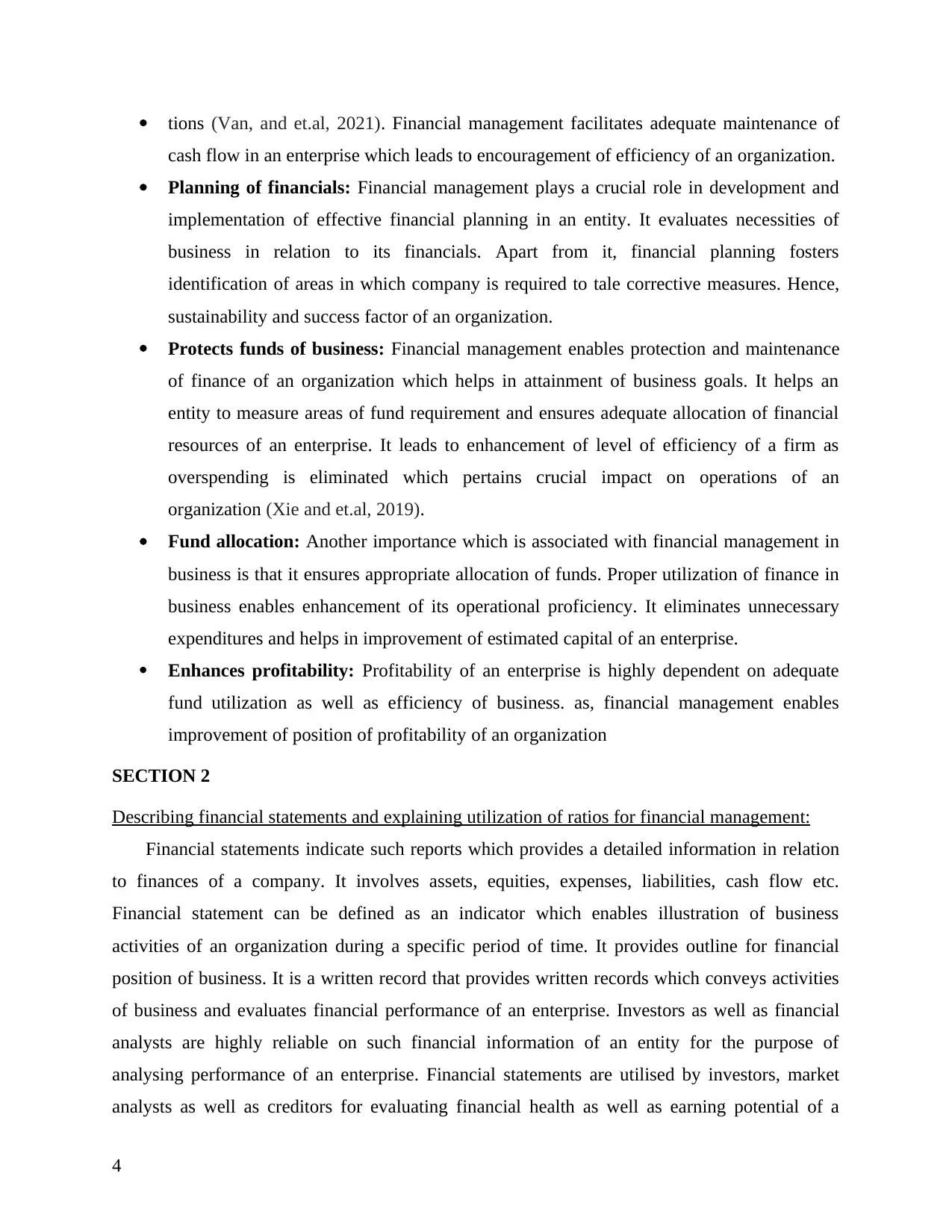
tions (Van, and et.al, 2021). Financial management facilitates adequate maintenance of
cash flow in an enterprise which leads to encouragement of efficiency of an organization.
Planning of financials: Financial management plays a crucial role in development and
implementation of effective financial planning in an entity. It evaluates necessities of
business in relation to its financials. Apart from it, financial planning fosters
identification of areas in which company is required to tale corrective measures. Hence,
sustainability and success factor of an organization.
Protects funds of business: Financial management enables protection and maintenance
of finance of an organization which helps in attainment of business goals. It helps an
entity to measure areas of fund requirement and ensures adequate allocation of financial
resources of an enterprise. It leads to enhancement of level of efficiency of a firm as
overspending is eliminated which pertains crucial impact on operations of an
organization (Xie and et.al, 2019).
Fund allocation: Another importance which is associated with financial management in
business is that it ensures appropriate allocation of funds. Proper utilization of finance in
business enables enhancement of its operational proficiency. It eliminates unnecessary
expenditures and helps in improvement of estimated capital of an enterprise.
Enhances profitability: Profitability of an enterprise is highly dependent on adequate
fund utilization as well as efficiency of business. as, financial management enables
improvement of position of profitability of an organization
SECTION 2
Describing financial statements and explaining utilization of ratios for financial management:
Financial statements indicate such reports which provides a detailed information in relation
to finances of a company. It involves assets, equities, expenses, liabilities, cash flow etc.
Financial statement can be defined as an indicator which enables illustration of business
activities of an organization during a specific period of time. It provides outline for financial
position of business. It is a written record that provides written records which conveys activities
of business and evaluates financial performance of an enterprise. Investors as well as financial
analysts are highly reliable on such financial information of an entity for the purpose of
analysing performance of an enterprise. Financial statements are utilised by investors, market
analysts as well as creditors for evaluating financial health as well as earning potential of a
4
cash flow in an enterprise which leads to encouragement of efficiency of an organization.
Planning of financials: Financial management plays a crucial role in development and
implementation of effective financial planning in an entity. It evaluates necessities of
business in relation to its financials. Apart from it, financial planning fosters
identification of areas in which company is required to tale corrective measures. Hence,
sustainability and success factor of an organization.
Protects funds of business: Financial management enables protection and maintenance
of finance of an organization which helps in attainment of business goals. It helps an
entity to measure areas of fund requirement and ensures adequate allocation of financial
resources of an enterprise. It leads to enhancement of level of efficiency of a firm as
overspending is eliminated which pertains crucial impact on operations of an
organization (Xie and et.al, 2019).
Fund allocation: Another importance which is associated with financial management in
business is that it ensures appropriate allocation of funds. Proper utilization of finance in
business enables enhancement of its operational proficiency. It eliminates unnecessary
expenditures and helps in improvement of estimated capital of an enterprise.
Enhances profitability: Profitability of an enterprise is highly dependent on adequate
fund utilization as well as efficiency of business. as, financial management enables
improvement of position of profitability of an organization
SECTION 2
Describing financial statements and explaining utilization of ratios for financial management:
Financial statements indicate such reports which provides a detailed information in relation
to finances of a company. It involves assets, equities, expenses, liabilities, cash flow etc.
Financial statement can be defined as an indicator which enables illustration of business
activities of an organization during a specific period of time. It provides outline for financial
position of business. It is a written record that provides written records which conveys activities
of business and evaluates financial performance of an enterprise. Investors as well as financial
analysts are highly reliable on such financial information of an entity for the purpose of
analysing performance of an enterprise. Financial statements are utilised by investors, market
analysts as well as creditors for evaluating financial health as well as earning potential of a
4
Paraphrase This Document
Need a fresh take? Get an instant paraphrase of this document with our AI Paraphraser
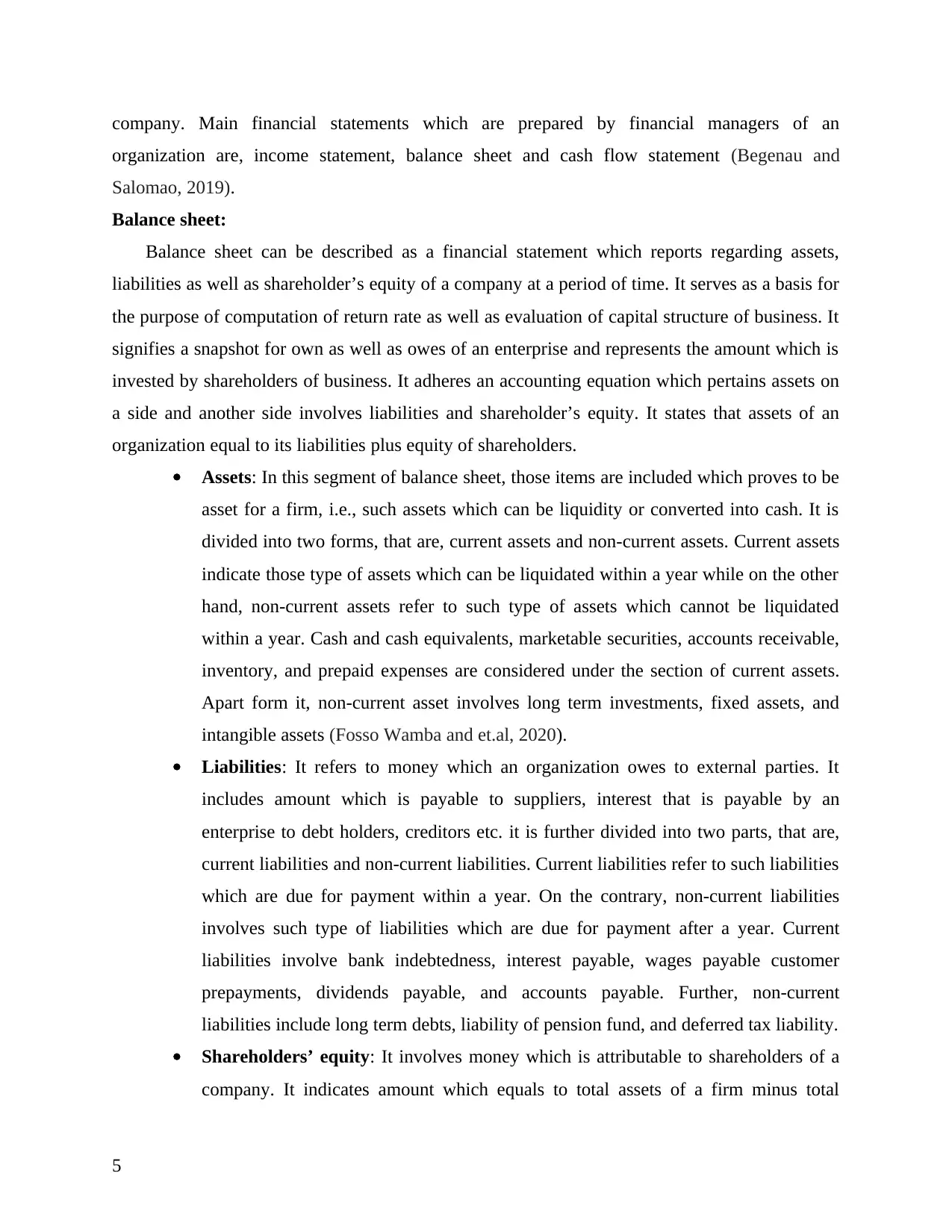
company. Main financial statements which are prepared by financial managers of an
organization are, income statement, balance sheet and cash flow statement (Begenau and
Salomao, 2019).
Balance sheet:
Balance sheet can be described as a financial statement which reports regarding assets,
liabilities as well as shareholder’s equity of a company at a period of time. It serves as a basis for
the purpose of computation of return rate as well as evaluation of capital structure of business. It
signifies a snapshot for own as well as owes of an enterprise and represents the amount which is
invested by shareholders of business. It adheres an accounting equation which pertains assets on
a side and another side involves liabilities and shareholder’s equity. It states that assets of an
organization equal to its liabilities plus equity of shareholders.
Assets: In this segment of balance sheet, those items are included which proves to be
asset for a firm, i.e., such assets which can be liquidity or converted into cash. It is
divided into two forms, that are, current assets and non-current assets. Current assets
indicate those type of assets which can be liquidated within a year while on the other
hand, non-current assets refer to such type of assets which cannot be liquidated
within a year. Cash and cash equivalents, marketable securities, accounts receivable,
inventory, and prepaid expenses are considered under the section of current assets.
Apart form it, non-current asset involves long term investments, fixed assets, and
intangible assets (Fosso Wamba and et.al, 2020).
Liabilities: It refers to money which an organization owes to external parties. It
includes amount which is payable to suppliers, interest that is payable by an
enterprise to debt holders, creditors etc. it is further divided into two parts, that are,
current liabilities and non-current liabilities. Current liabilities refer to such liabilities
which are due for payment within a year. On the contrary, non-current liabilities
involves such type of liabilities which are due for payment after a year. Current
liabilities involve bank indebtedness, interest payable, wages payable customer
prepayments, dividends payable, and accounts payable. Further, non-current
liabilities include long term debts, liability of pension fund, and deferred tax liability.
Shareholders’ equity: It involves money which is attributable to shareholders of a
company. It indicates amount which equals to total assets of a firm minus total
5
organization are, income statement, balance sheet and cash flow statement (Begenau and
Salomao, 2019).
Balance sheet:
Balance sheet can be described as a financial statement which reports regarding assets,
liabilities as well as shareholder’s equity of a company at a period of time. It serves as a basis for
the purpose of computation of return rate as well as evaluation of capital structure of business. It
signifies a snapshot for own as well as owes of an enterprise and represents the amount which is
invested by shareholders of business. It adheres an accounting equation which pertains assets on
a side and another side involves liabilities and shareholder’s equity. It states that assets of an
organization equal to its liabilities plus equity of shareholders.
Assets: In this segment of balance sheet, those items are included which proves to be
asset for a firm, i.e., such assets which can be liquidity or converted into cash. It is
divided into two forms, that are, current assets and non-current assets. Current assets
indicate those type of assets which can be liquidated within a year while on the other
hand, non-current assets refer to such type of assets which cannot be liquidated
within a year. Cash and cash equivalents, marketable securities, accounts receivable,
inventory, and prepaid expenses are considered under the section of current assets.
Apart form it, non-current asset involves long term investments, fixed assets, and
intangible assets (Fosso Wamba and et.al, 2020).
Liabilities: It refers to money which an organization owes to external parties. It
includes amount which is payable to suppliers, interest that is payable by an
enterprise to debt holders, creditors etc. it is further divided into two parts, that are,
current liabilities and non-current liabilities. Current liabilities refer to such liabilities
which are due for payment within a year. On the contrary, non-current liabilities
involves such type of liabilities which are due for payment after a year. Current
liabilities involve bank indebtedness, interest payable, wages payable customer
prepayments, dividends payable, and accounts payable. Further, non-current
liabilities include long term debts, liability of pension fund, and deferred tax liability.
Shareholders’ equity: It involves money which is attributable to shareholders of a
company. It indicates amount which equals to total assets of a firm minus total
5
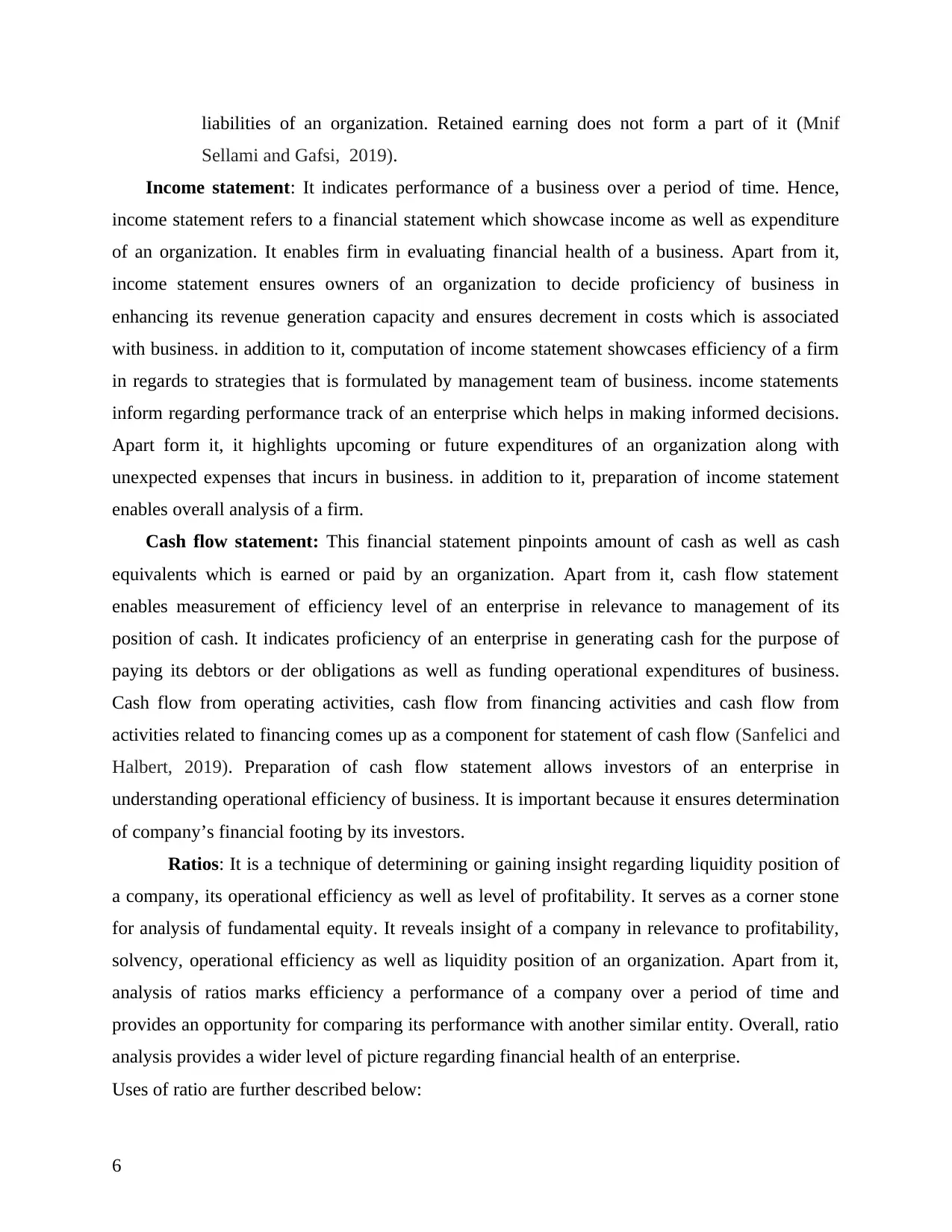
liabilities of an organization. Retained earning does not form a part of it (Mnif
Sellami and Gafsi, 2019).
Income statement: It indicates performance of a business over a period of time. Hence,
income statement refers to a financial statement which showcase income as well as expenditure
of an organization. It enables firm in evaluating financial health of a business. Apart from it,
income statement ensures owners of an organization to decide proficiency of business in
enhancing its revenue generation capacity and ensures decrement in costs which is associated
with business. in addition to it, computation of income statement showcases efficiency of a firm
in regards to strategies that is formulated by management team of business. income statements
inform regarding performance track of an enterprise which helps in making informed decisions.
Apart form it, it highlights upcoming or future expenditures of an organization along with
unexpected expenses that incurs in business. in addition to it, preparation of income statement
enables overall analysis of a firm.
Cash flow statement: This financial statement pinpoints amount of cash as well as cash
equivalents which is earned or paid by an organization. Apart from it, cash flow statement
enables measurement of efficiency level of an enterprise in relevance to management of its
position of cash. It indicates proficiency of an enterprise in generating cash for the purpose of
paying its debtors or der obligations as well as funding operational expenditures of business.
Cash flow from operating activities, cash flow from financing activities and cash flow from
activities related to financing comes up as a component for statement of cash flow (Sanfelici and
Halbert, 2019). Preparation of cash flow statement allows investors of an enterprise in
understanding operational efficiency of business. It is important because it ensures determination
of company’s financial footing by its investors.
Ratios: It is a technique of determining or gaining insight regarding liquidity position of
a company, its operational efficiency as well as level of profitability. It serves as a corner stone
for analysis of fundamental equity. It reveals insight of a company in relevance to profitability,
solvency, operational efficiency as well as liquidity position of an organization. Apart from it,
analysis of ratios marks efficiency a performance of a company over a period of time and
provides an opportunity for comparing its performance with another similar entity. Overall, ratio
analysis provides a wider level of picture regarding financial health of an enterprise.
Uses of ratio are further described below:
6
Sellami and Gafsi, 2019).
Income statement: It indicates performance of a business over a period of time. Hence,
income statement refers to a financial statement which showcase income as well as expenditure
of an organization. It enables firm in evaluating financial health of a business. Apart from it,
income statement ensures owners of an organization to decide proficiency of business in
enhancing its revenue generation capacity and ensures decrement in costs which is associated
with business. in addition to it, computation of income statement showcases efficiency of a firm
in regards to strategies that is formulated by management team of business. income statements
inform regarding performance track of an enterprise which helps in making informed decisions.
Apart form it, it highlights upcoming or future expenditures of an organization along with
unexpected expenses that incurs in business. in addition to it, preparation of income statement
enables overall analysis of a firm.
Cash flow statement: This financial statement pinpoints amount of cash as well as cash
equivalents which is earned or paid by an organization. Apart from it, cash flow statement
enables measurement of efficiency level of an enterprise in relevance to management of its
position of cash. It indicates proficiency of an enterprise in generating cash for the purpose of
paying its debtors or der obligations as well as funding operational expenditures of business.
Cash flow from operating activities, cash flow from financing activities and cash flow from
activities related to financing comes up as a component for statement of cash flow (Sanfelici and
Halbert, 2019). Preparation of cash flow statement allows investors of an enterprise in
understanding operational efficiency of business. It is important because it ensures determination
of company’s financial footing by its investors.
Ratios: It is a technique of determining or gaining insight regarding liquidity position of
a company, its operational efficiency as well as level of profitability. It serves as a corner stone
for analysis of fundamental equity. It reveals insight of a company in relevance to profitability,
solvency, operational efficiency as well as liquidity position of an organization. Apart from it,
analysis of ratios marks efficiency a performance of a company over a period of time and
provides an opportunity for comparing its performance with another similar entity. Overall, ratio
analysis provides a wider level of picture regarding financial health of an enterprise.
Uses of ratio are further described below:
6
⊘ This is a preview!⊘
Do you want full access?
Subscribe today to unlock all pages.

Trusted by 1+ million students worldwide
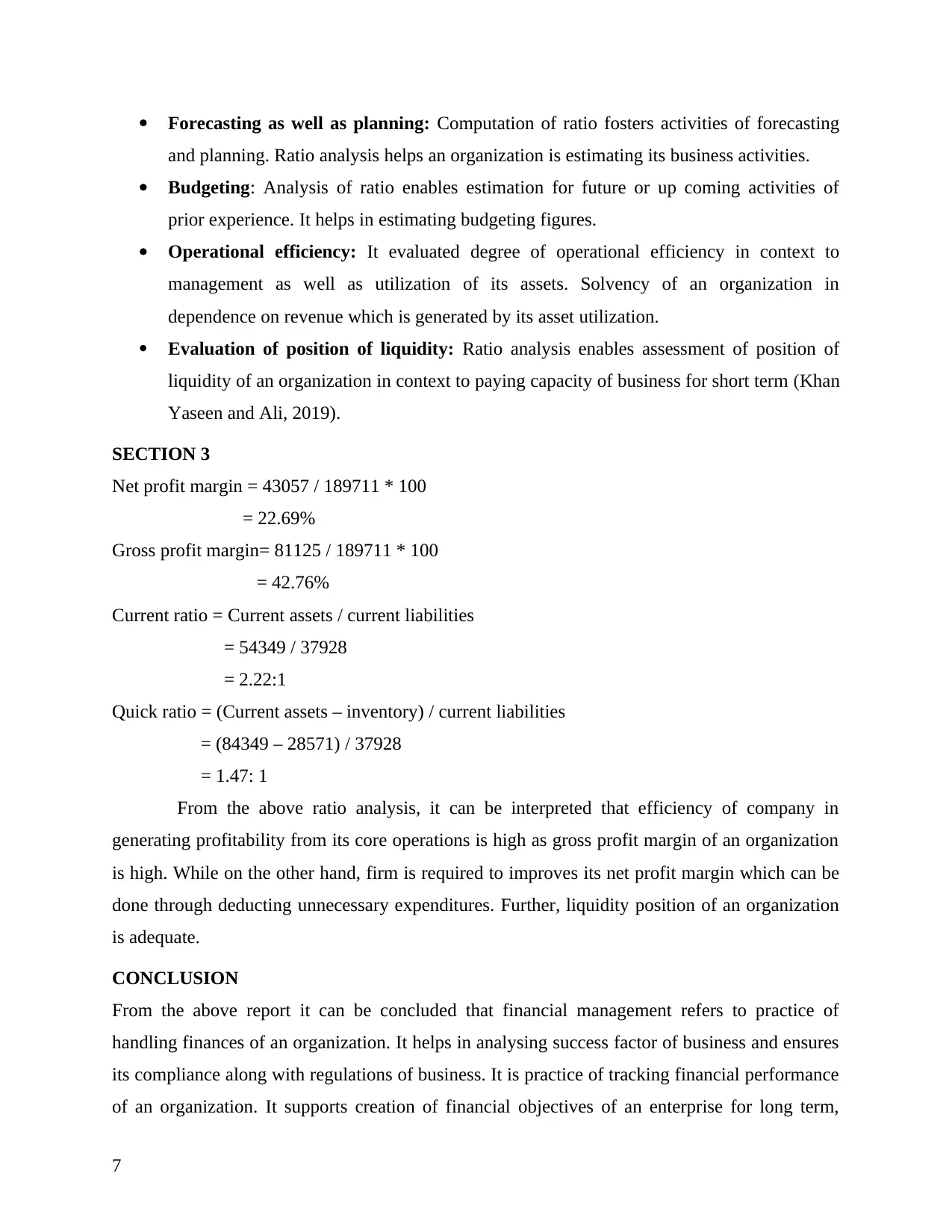
Forecasting as well as planning: Computation of ratio fosters activities of forecasting
and planning. Ratio analysis helps an organization is estimating its business activities.
Budgeting: Analysis of ratio enables estimation for future or up coming activities of
prior experience. It helps in estimating budgeting figures.
Operational efficiency: It evaluated degree of operational efficiency in context to
management as well as utilization of its assets. Solvency of an organization in
dependence on revenue which is generated by its asset utilization.
Evaluation of position of liquidity: Ratio analysis enables assessment of position of
liquidity of an organization in context to paying capacity of business for short term (Khan
Yaseen and Ali, 2019).
SECTION 3
Net profit margin = 43057 / 189711 * 100
= 22.69%
Gross profit margin= 81125 / 189711 * 100
= 42.76%
Current ratio = Current assets / current liabilities
= 54349 / 37928
= 2.22:1
Quick ratio = (Current assets – inventory) / current liabilities
= (84349 – 28571) / 37928
= 1.47: 1
From the above ratio analysis, it can be interpreted that efficiency of company in
generating profitability from its core operations is high as gross profit margin of an organization
is high. While on the other hand, firm is required to improves its net profit margin which can be
done through deducting unnecessary expenditures. Further, liquidity position of an organization
is adequate.
CONCLUSION
From the above report it can be concluded that financial management refers to practice of
handling finances of an organization. It helps in analysing success factor of business and ensures
its compliance along with regulations of business. It is practice of tracking financial performance
of an organization. It supports creation of financial objectives of an enterprise for long term,
7
and planning. Ratio analysis helps an organization is estimating its business activities.
Budgeting: Analysis of ratio enables estimation for future or up coming activities of
prior experience. It helps in estimating budgeting figures.
Operational efficiency: It evaluated degree of operational efficiency in context to
management as well as utilization of its assets. Solvency of an organization in
dependence on revenue which is generated by its asset utilization.
Evaluation of position of liquidity: Ratio analysis enables assessment of position of
liquidity of an organization in context to paying capacity of business for short term (Khan
Yaseen and Ali, 2019).
SECTION 3
Net profit margin = 43057 / 189711 * 100
= 22.69%
Gross profit margin= 81125 / 189711 * 100
= 42.76%
Current ratio = Current assets / current liabilities
= 54349 / 37928
= 2.22:1
Quick ratio = (Current assets – inventory) / current liabilities
= (84349 – 28571) / 37928
= 1.47: 1
From the above ratio analysis, it can be interpreted that efficiency of company in
generating profitability from its core operations is high as gross profit margin of an organization
is high. While on the other hand, firm is required to improves its net profit margin which can be
done through deducting unnecessary expenditures. Further, liquidity position of an organization
is adequate.
CONCLUSION
From the above report it can be concluded that financial management refers to practice of
handling finances of an organization. It helps in analysing success factor of business and ensures
its compliance along with regulations of business. It is practice of tracking financial performance
of an organization. It supports creation of financial objectives of an enterprise for long term,
7
Paraphrase This Document
Need a fresh take? Get an instant paraphrase of this document with our AI Paraphraser

enables making of informed decisions, and yields insight of business in relevance to funds and
investments. Financial statements are analysed in case of financial management. Financial
statement includes three types of components, that are balance sheet, cash flow statement as well
as income statement. Apart from it, ratio analysis helps in evaluating financial position of an
enterprise.
8
investments. Financial statements are analysed in case of financial management. Financial
statement includes three types of components, that are balance sheet, cash flow statement as well
as income statement. Apart from it, ratio analysis helps in evaluating financial position of an
enterprise.
8
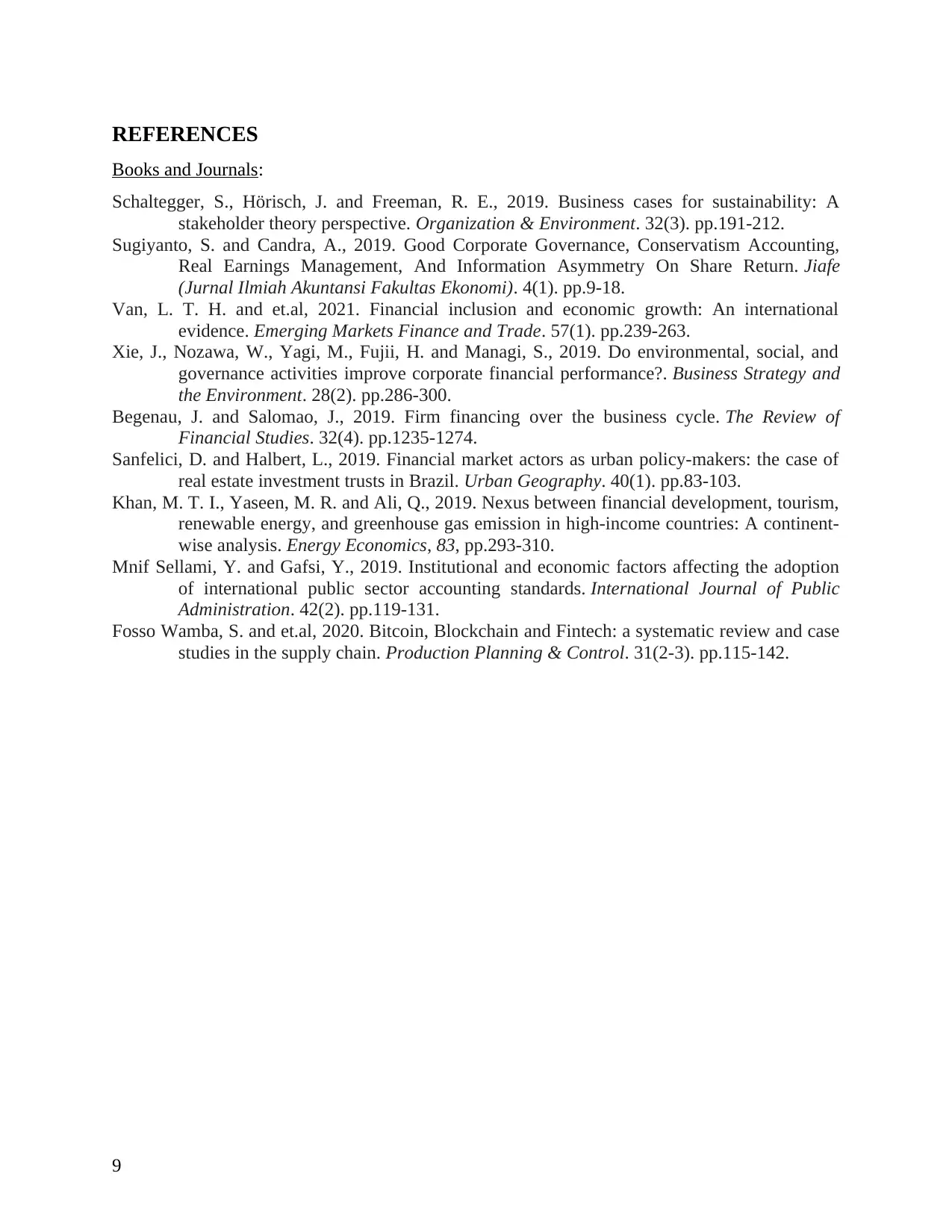
REFERENCES
Books and Journals:
Schaltegger, S., Hörisch, J. and Freeman, R. E., 2019. Business cases for sustainability: A
stakeholder theory perspective. Organization & Environment. 32(3). pp.191-212.
Sugiyanto, S. and Candra, A., 2019. Good Corporate Governance, Conservatism Accounting,
Real Earnings Management, And Information Asymmetry On Share Return. Jiafe
(Jurnal Ilmiah Akuntansi Fakultas Ekonomi). 4(1). pp.9-18.
Van, L. T. H. and et.al, 2021. Financial inclusion and economic growth: An international
evidence. Emerging Markets Finance and Trade. 57(1). pp.239-263.
Xie, J., Nozawa, W., Yagi, M., Fujii, H. and Managi, S., 2019. Do environmental, social, and
governance activities improve corporate financial performance?. Business Strategy and
the Environment. 28(2). pp.286-300.
Begenau, J. and Salomao, J., 2019. Firm financing over the business cycle. The Review of
Financial Studies. 32(4). pp.1235-1274.
Sanfelici, D. and Halbert, L., 2019. Financial market actors as urban policy-makers: the case of
real estate investment trusts in Brazil. Urban Geography. 40(1). pp.83-103.
Khan, M. T. I., Yaseen, M. R. and Ali, Q., 2019. Nexus between financial development, tourism,
renewable energy, and greenhouse gas emission in high-income countries: A continent-
wise analysis. Energy Economics, 83, pp.293-310.
Mnif Sellami, Y. and Gafsi, Y., 2019. Institutional and economic factors affecting the adoption
of international public sector accounting standards. International Journal of Public
Administration. 42(2). pp.119-131.
Fosso Wamba, S. and et.al, 2020. Bitcoin, Blockchain and Fintech: a systematic review and case
studies in the supply chain. Production Planning & Control. 31(2-3). pp.115-142.
9
Books and Journals:
Schaltegger, S., Hörisch, J. and Freeman, R. E., 2019. Business cases for sustainability: A
stakeholder theory perspective. Organization & Environment. 32(3). pp.191-212.
Sugiyanto, S. and Candra, A., 2019. Good Corporate Governance, Conservatism Accounting,
Real Earnings Management, And Information Asymmetry On Share Return. Jiafe
(Jurnal Ilmiah Akuntansi Fakultas Ekonomi). 4(1). pp.9-18.
Van, L. T. H. and et.al, 2021. Financial inclusion and economic growth: An international
evidence. Emerging Markets Finance and Trade. 57(1). pp.239-263.
Xie, J., Nozawa, W., Yagi, M., Fujii, H. and Managi, S., 2019. Do environmental, social, and
governance activities improve corporate financial performance?. Business Strategy and
the Environment. 28(2). pp.286-300.
Begenau, J. and Salomao, J., 2019. Firm financing over the business cycle. The Review of
Financial Studies. 32(4). pp.1235-1274.
Sanfelici, D. and Halbert, L., 2019. Financial market actors as urban policy-makers: the case of
real estate investment trusts in Brazil. Urban Geography. 40(1). pp.83-103.
Khan, M. T. I., Yaseen, M. R. and Ali, Q., 2019. Nexus between financial development, tourism,
renewable energy, and greenhouse gas emission in high-income countries: A continent-
wise analysis. Energy Economics, 83, pp.293-310.
Mnif Sellami, Y. and Gafsi, Y., 2019. Institutional and economic factors affecting the adoption
of international public sector accounting standards. International Journal of Public
Administration. 42(2). pp.119-131.
Fosso Wamba, S. and et.al, 2020. Bitcoin, Blockchain and Fintech: a systematic review and case
studies in the supply chain. Production Planning & Control. 31(2-3). pp.115-142.
9
⊘ This is a preview!⊘
Do you want full access?
Subscribe today to unlock all pages.

Trusted by 1+ million students worldwide
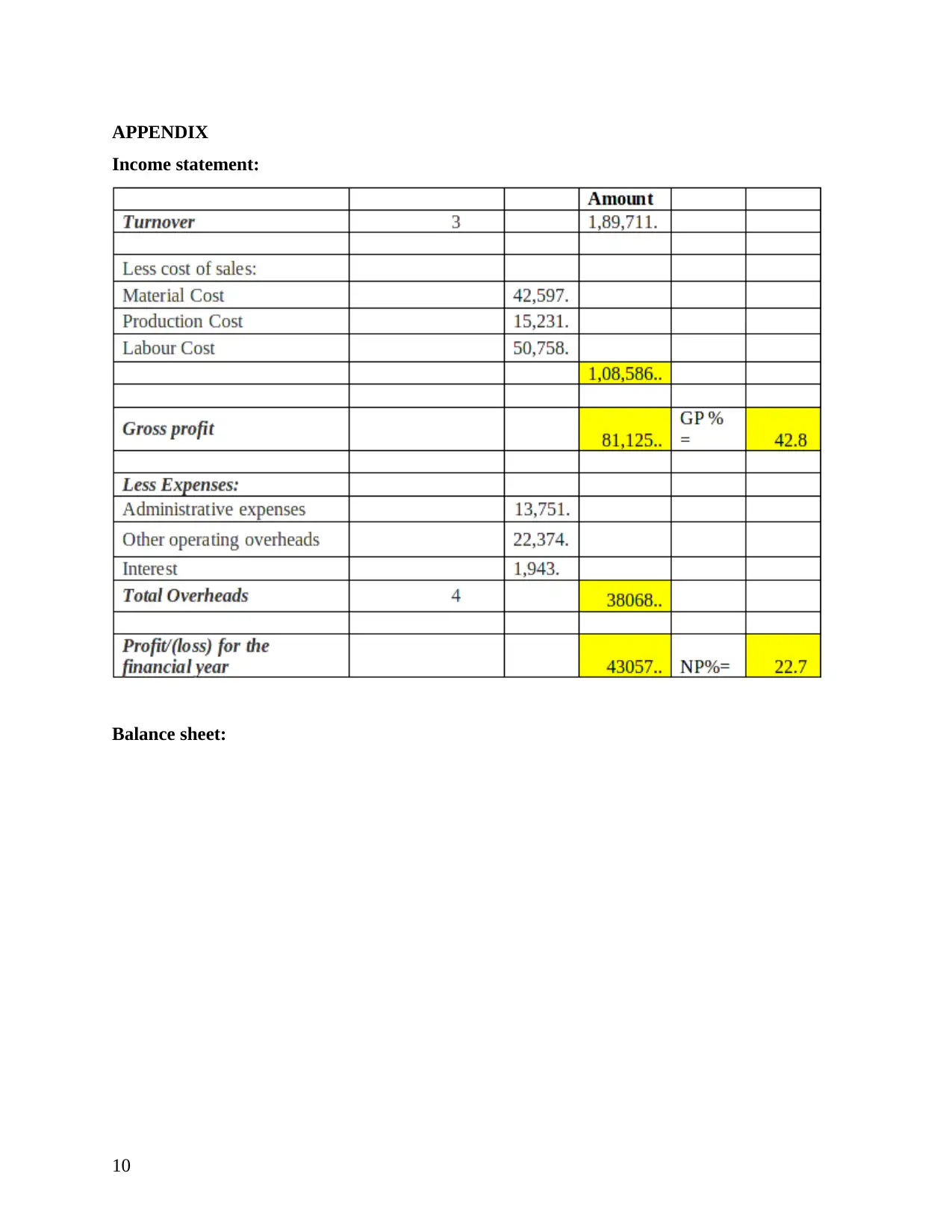
APPENDIX
Income statement:
Balance sheet:
10
Income statement:
Balance sheet:
10
Paraphrase This Document
Need a fresh take? Get an instant paraphrase of this document with our AI Paraphraser
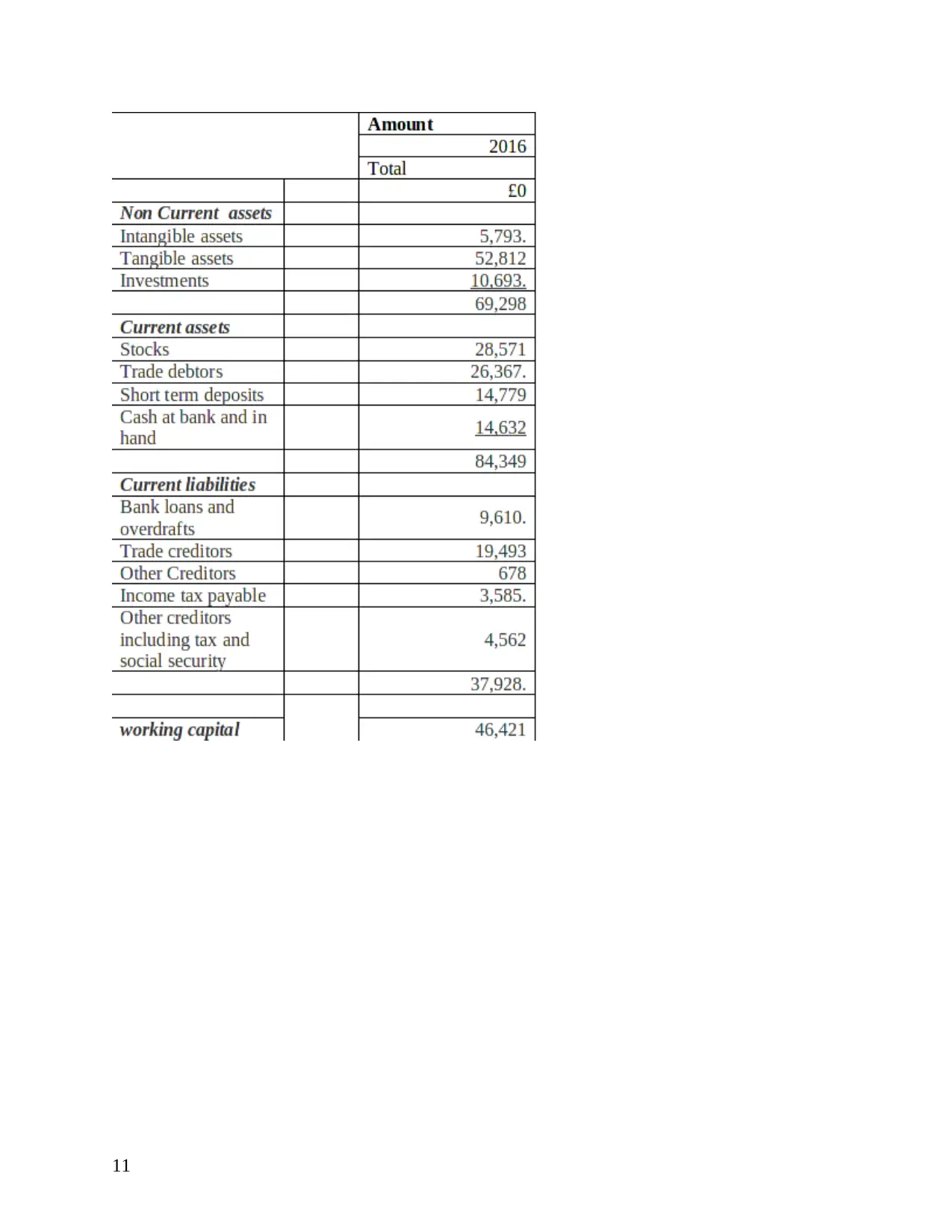
11
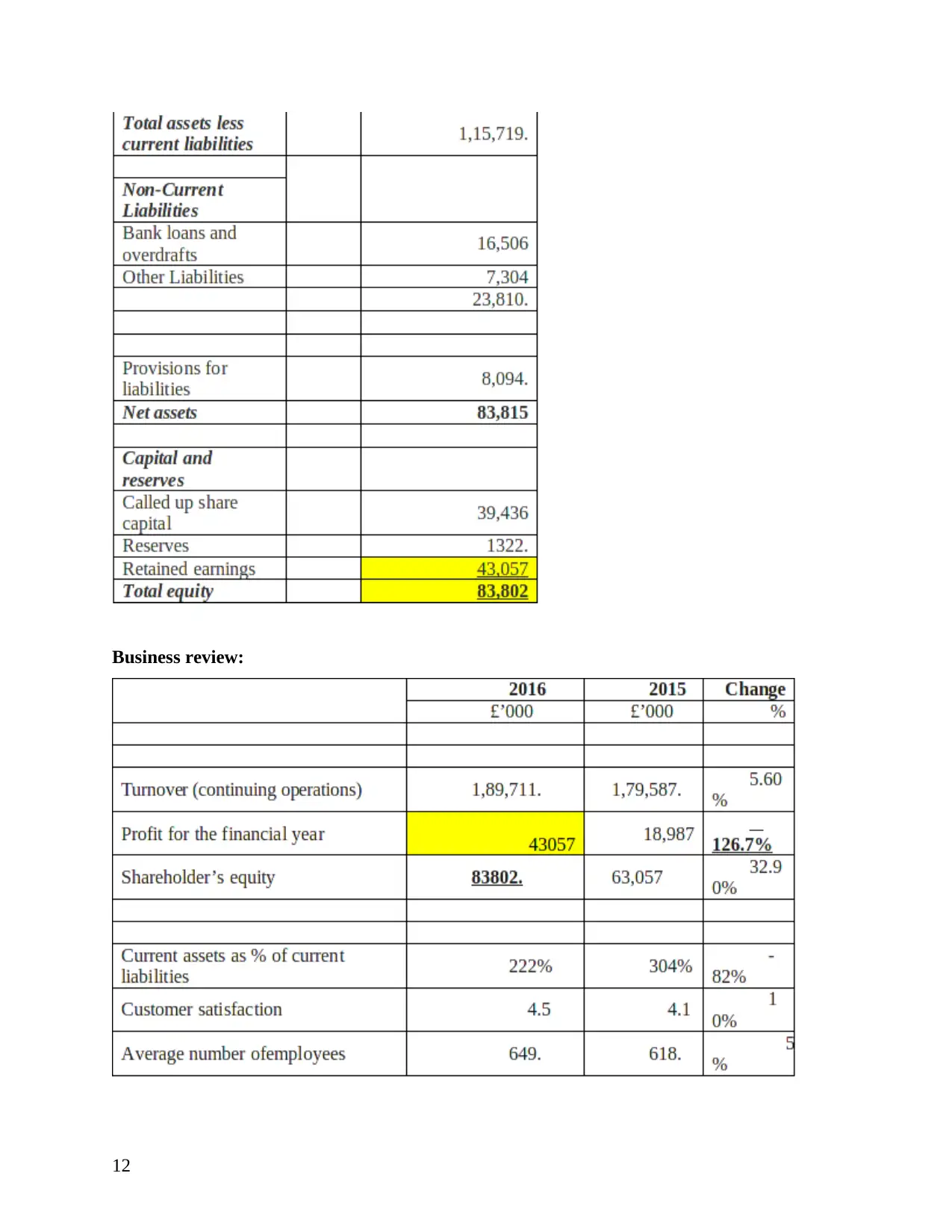
Business review:
12
12
⊘ This is a preview!⊘
Do you want full access?
Subscribe today to unlock all pages.

Trusted by 1+ million students worldwide
1 out of 13
Related Documents
Your All-in-One AI-Powered Toolkit for Academic Success.
+13062052269
info@desklib.com
Available 24*7 on WhatsApp / Email
![[object Object]](/_next/static/media/star-bottom.7253800d.svg)
Unlock your academic potential
Copyright © 2020–2025 A2Z Services. All Rights Reserved. Developed and managed by ZUCOL.




